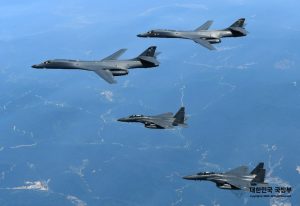In their March article for The Diplomat, Jihoon Yu and Erik French argued that South Korea should double down on the Korean Massive Punishment and Retaliation (KMPR) aspect of its “Three Axis” conventional deterrence strategy. Their argument is founded on the idea that the Kill Chain and the Korean Air and Missile Defense (KAMD) components of the strategy – which are premised on deterrence by denial – are of diminishing utility. Due to advancements in North Korea’s arsenal of nuclear delivery systems, they argue, it is less and less credible that Kill Chain and the KAMD can defeat a North Korean nuclear assault. By emphasizing KMPR instead, the threat of a violent punishment response would enhance deterrence despite North Korea’s rapidly improving nuclear capabilities.
This argument has some merits, and the authors are correct in emphasizing that it is highly difficult to initiate a pre-emptive counterforce strike against North Korea’s nuclear weapons. Nevertheless, we believe that South Korea’s military response to North Korean nuclear developments deserves some further examination.
First, it should be noted that deterrence is not a static relationship. As South Korea and the United States prioritize more advanced conventional methods to counter North Korean nuclear weapons, military planners in Pyongyang will almost certainly seek to design around such methods. Put differently – North Korea’s development of a more diverse and survivable nuclear arsenal is an expected development and hence should have been factored into any South Korean deterrence strategy. Indeed, if South Korea intends to continue along the path of conventional counterforce, it should be ready for long term investments in new capabilities and continuous evolutions in strategy and doctrine.
Second, it is important to highlight that the deterrence logic of Kill Chain is premised on instilling uncertainty in North Korean leaders – and not on the ability to execute a preemptive strike with complete confidence. Even when North Korea’s nuclear delivery arsenal was less advanced and diversified, the South Korean system was not perfect, with a high potential for failure. Nevertheless, Kill Chain, coupled with the KAMD, presents the North Korean military with a planning dilemma and produces uncertainty about their ability to conduct a nuclear strike. Continued investments in both systems that will improve targeting and execution alongside better coordination with the United States will continue to present complicating factors for North Korea. Despite the improving North Korean nuclear arsenal, we therefore argue that Kill Chain maintains some deterrent value.
Third, the KMPR is not a panacea to the deterrence challenges facing South Korea. Just like Kill Chain, the KMPR is an extremely challenging plan to execute. Any initiation likely will occur during or after an attempted North Korean nuclear attack, an event that will almost certainly also involve or result in a conventional assault from the North as well. In other words, when implementing the KMPR, the South Korean and U.S. militaries will likely be dealing with multiple high-intensity threats, which will draw significant resources. Just like Kill Chain and the KAMD, the KMPR therefore faces credibility issues.
Moreover, as with all punishment approaches to deterrence, the KMPR leaves the level of acceptable damage to be decided by the adversary. In this case, the North Korean leadership gets to choose its level of tolerance for punishment, and therefore South Korea will need to demonstrate a credible ability to inflict a substantial level of damage. As the conflict in Ukraine has demonstrated, Russia’s use of large numbers of standoff and long-range munitions against civilian and military targets has utterly failed to alter Ukrainian resolve or undermine its defense posture. This reality should be deeply considered by South Korean defense planners.
Finally, heightening investment in the KMPR will naturally sacrifice investments in other areas of South Korea’s deterrent and defense posture. After all, no defense budget is a bottomless money pit, and the South Korean military faces one of the most hostile security environments in the world. It, therefore, has multiple areas that require continued investment.
All of this speaks to the difficulty of maintaining a credible deterrence and defense posture when in a sustained long-term deterrent dynamic. On the Korean Peninsula, there is no mutually acceptable equilibrium. North Korea is seeking to develop the ability to threaten South Korea with nuclear weapons, whereas South Korea is seeking to deny North Korea this ability. Both states therefore have strong incentives to continue to design around the other. Indeed, it is likely that the action-reaction dynamic described above could even intensify.
What can be done through conventional means to enhance deterrence on the peninsula? Continued investment in the KMPR is of course useful, but equally important is continued investment both in the other two axes of the deterrence strategy and in the rest of the South Korean fighting force. A conventional deterrence strategy premised both on denial and punishment will always be a risk-laden approach to deterring a nuclear power. As its deterrent potential lies in the introduction of uncertainty into North Korea’s calculations, relying too heavily on one element (and indeed, the one element that places the burden of acceptance on the adversary) is not the optimal approach.
More broadly, the unfortunate and uncomfortable truth is that South Korea’s deterrence challenges are manifest and that no approach is foolproof. Going forward, South Korea – along with the United States – needs to find a military and diplomatic approach that maximizes effect versus investment and prioritizes flexibility in the face of an opponent that has demonstrated a high level of innovation in designing around Seoul’s best efforts to deter them. As North Korea’s nuclear arsenal continues to improve, finding that approach will only become more challenging.
That is why calls for South Korean nuclear weapons are gaining traction in political, public and expert circles – and are likely to intensify in the years ahead.
































